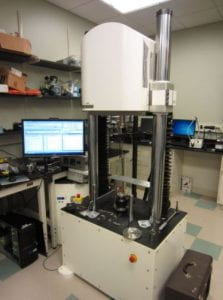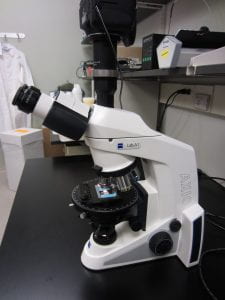Multiscale Assessments Research Core (DCMR Research Core)
Mechanical Loading and Measurement Lab
Faysal Haque
Faysal Haque has experience in manufacturing processes, mechanical testing, and machining. He completed his Masters in Mechanical Engineering from Miami University. His research work was focused on the ultralow wear rate of the metal filled fluropolymer composites for dry sliding applications. Prior to his Masters, he worked in a leading manufacturing plant as a process engineer. His research interest is in the biomechanics of soft-tissue and their different mechanical failures. Faysal Haque works as a Research Associate both for Elliott Lab and DCMR.

Facilities and Resources:
The Mechanical Loading and Measurement Laboratory houses equipment in several spaces at the University of Delaware including Star Health Science Complex, rm 125, Spencer Lab rm 202, 117D at 15 Innovation Way, and the Life Science Research Facility (LSRF). The equipment in these space are specialized for multiscale mechanical loading and measurement for a variety of sample types including both soft and hard materials. The DCMR Biomechanical Engineer is available to provide expertise and training on equipment within the facilities as well as consult on experimental design.
Services offered:
- Analysis Assistance
- Assay/Protocol Development
- Consultation/Training
- Fixture design
- Project development
Equipment:
3-Point Bending
Description: coming soon
Location: Spencer Lab 202
Contact person: Faysal Haque
22N LM1
Description: coming soon
Location: Life Science Research Facility (LSRF) 206
Contact person: Faysal Haque
Aurora Scientific 1300A 3-in-1 Whole Animal Muscle Stimulator for Mice

The 3-in1 whole animal muscle stimulator is a high performing, precise test system to test tensile and other mechanical properties of muscle. This system combines in situ, in vivo and in vitro muscle testing using one platform to study muscle physiology in rodent (mouse) subjects. Features include a precision force transducer for in situ tests, force transducer with plate for in vivo tests, and 25mL horizontal bath for in vitro tests. Peak forces range from 0.5 to 10N.
Location: Life Science Research Facility (LSRF) 203A
Contact person: Dr. Mary Boggs
BioRobotic Joint Testing System
Description: Kuka KR 160 R1570 nano robot for multi-axial biomechanical testing of musculoskeletal joints (e.g., knee, hip, spine, and others). Human joints are loaded in all six degrees of freedom (3 perpendicular forces and 3 perpendicular moments). Replication of these physiological loads and moments, and measurement of all six corresponding deformations is needed to evaluate the biomechanical function of human joints.
Location: Star Health Science Complex (STAR)
Contact person:
Deli Slicer

A deli slicer is available for rapid rough cutting of soft tissue, which is usually cut while semi-frozen and embedded in a cellulose gel. For tough tissues, the resulting slices are somewhat uneven in thickness, but better than using a vibratome or cutting by hand. This is a quicker but lesser-quality alternative to the Leica SM2400 freezing stage microtome.
Location: Star Health Science Complex (STAR) 125
Contact person: Faysal Haque
Dimension ICON Atomic Force Microscope
Description: coming soon
Location: 15 Innovation Way 117D
Contact person: Dr. Mary Boggs
Instron 5943


Versatile and easy to use test frame for uniaxial tension or compression with small–medium loads. Ideal for static and slowly varying tests. More often than not this is the tester you should use.
- Displacement range: ~ 1 m
- Displacement rate: arbitrarily slow to ~ 10 mm/s
- Load cells: 10 N, 100 N, 1 kN.
- Bath for testing in fluid
- Single-column test frame provides ample working space.
- A variety of test fixtures (accessories) are available, including a T-slot table, a wide assortment of tensile grips, and compression platens.
- Often used for uniaxial tension, unconfined compression, confined compression, and 3-point bending.
Location: Star Health Science Complex (STAR) 125
Contact person: Faysal Haque
Leica SM2400 Sledge Microtome with freezing stage
 The freezing stage allows soft tissues to be cut to precise dimensions, with parallel faces and thus uniform thickness. The freezing stage is somewhat larger than typically available in a cryotome rotary microtome.
The freezing stage allows soft tissues to be cut to precise dimensions, with parallel faces and thus uniform thickness. The freezing stage is somewhat larger than typically available in a cryotome rotary microtome.
Location: Star Health Science Complex (STAR) 125
Contact person: Faysal Haque
Micro-scale uniaxial testing system, 25 N axial load

Micro-scale uniaxial testing system, 25 N axial load: (custom made) a testing system including a motorized linear stage (25 N, 25.4 mm stroke, microstep size resolution of 0.0476 µm, speed resolution of 0.00022 mm/s) that is mountable on inverted confocal microscopes. LabView digital control software. Accessories include 10N and 45N load cells and a custom saline bath.
Location: Star Health Science Complex (STAR) 125
Contact person: Faysal Haque
NAC HX-7 High-Speed Camera
 High-resolution and high-framerate video camera. This camera configuration maximizes resolution at the expense of exhibiting a mid-range framerate. Generally this is the correct trade-off for tests of biological tissue.
High-resolution and high-framerate video camera. This camera configuration maximizes resolution at the expense of exhibiting a mid-range framerate. Generally this is the correct trade-off for tests of biological tissue.
- 2560 × 1920 px @ 850 fps
- 1920 × 1080 px @ 2000 fps
- Resolution may be sacrificed further for greater framerate.
- Macro (1× magnification) capable: 30 mm × 20 mm field of view at ~ 40 cm working distance.
- 32 GB memory buffer
Location: Star Health Science Complex (STAR) 125
Contact person: Faysal Haque
Orthoscan Mini C-Arm Fluoroscope
 Continuous low-dose x-ray imaging. Still photos may be triggered using a footswitch. Particularly useful for guided injection or minimally invasive surgery and joint alignment.
Continuous low-dose x-ray imaging. Still photos may be triggered using a footswitch. Particularly useful for guided injection or minimally invasive surgery and joint alignment.
Location: Star Health Science Complex (STAR) 125
Contact person: Faysal Haque
Scanning Laser Interferometer
 The scanning laser interferometer measures the height profile (i.e., cross-sectional area) of a specimen without contact, which is helpful when the specimen is too soft for accurate micrometer measurements. The specimen is placed flat on an x–y stage and the laser interferometer records a height profile as the x–y stage is traversed.
The scanning laser interferometer measures the height profile (i.e., cross-sectional area) of a specimen without contact, which is helpful when the specimen is too soft for accurate micrometer measurements. The specimen is placed flat on an x–y stage and the laser interferometer records a height profile as the x–y stage is traversed.
Location: Star Health Science Complex (STAR) 125
Contact person: Faysal Haque
TA Instrument ElectroForce (Bose) 3510 AT, 7500 N axial load with torsion


Dynamic uniaxial tension–compression and torsion at moderate loads. Ideal for cyclic testing and high displacement rates. This test frame should be used when the Instron 5943 does not provide adequate performance.
- Displacement range: ± 25 mm. Starting at ~ 0 mm is recommended.
- Displacement rate: 0.025 μm/s to 1.5 m/s, or 0.00001 Hz to 100 Hz.
- Max axial load: 7500 N dynamic, 5300 N static
- Motorized crosshead height adjustment.
- Rotation range: ± 3600° at up to 50 Hz
- Max torque: 49 N·m dynamic, 42 N·m static
- Load cells: 1250 N axial, 7500 N axial, 70 N·m torque
- Test space: 559 mm wide × 2700 mm tall
- Temperature-controlled bath for testing in fluid
- Accessories include MRI-compatible (available at CBBI) locking compression fixtures
Location: Star Health Science Complex (STAR) 125
Contact person: Faysal Haque
TA Instruments ElectroForce (Bose) 3230 AT, 450 N axial load with torsion
 Dynamic uniaxial tension–compression and torsion at small loads. Ideal for cyclic testing and high displacement rates. This test frame should be used when the Instron 5943 does not provide adequate performance.
Dynamic uniaxial tension–compression and torsion at small loads. Ideal for cyclic testing and high displacement rates. This test frame should be used when the Instron 5943 does not provide adequate performance.
- Displacement range: ± 12.5 mm. Starting at ~ 0 mm is recommended
- Displacement rate: 0.0065 μm/s to 3.2 m/s, or 0.00001 Hz to 200 Hz
- Max axial load: 450 N dynamic, 320 N static
- Manual crosshead height adjustment with microadjust
- Rotation range: ± 3600° at up to 100 Hz
- Max torque: 5.6 N·m
- Load cells: 10 N axial, 45 N axial, 450 N axial, 0.2 N·m torque, 5.6 N torque
- Test space: 355 mm wide × 417 mm tall (340 mm w/ torsion motor) × 279 mm deep
- Temperature-controlled bath for testing in fluid
- Adapters for Instron test fixtures are available
Location: Star Health Science Complex (STAR) 125
Contact Person: Faysal Haque
TA Instruments ElectroForce 400N TestBench
 Dynamic uniaxial tension–compression in a horizontal configuration, up to 400 N. Ideal for cyclic testing and high displacement rates. Convenient for small animal work.
Dynamic uniaxial tension–compression in a horizontal configuration, up to 400 N. Ideal for cyclic testing and high displacement rates. Convenient for small animal work.
- Displacement range: ± 6.5 mm. Starting at ~ 0 mm is recommended
- Cycle frequency up to 100 Hz
- Max axial load 400 N dynamic, ~ 280 N static.
- Load cells: 400 N, 225 N, 22 N (PID only), 5 N (PID only)
- Available test space up to 21.9” (without load cell)
- Adapters allow use of Instron 12 mm socket fixtures
Location: Life Science Research Facility (LSRF) 204
Contact person: Faysal Haque
Tekscan K-scan
Description: coming soon
Location: Spencer Lab 208
Contact person:
Vic-2D Digital Image Correlation Software
 Measure 2D strain fields from a time lapse image series of a specimen with a speckle-patterned surface. Typically used for analysis of uniaxial or biaxial tension test data.
Measure 2D strain fields from a time lapse image series of a specimen with a speckle-patterned surface. Typically used for analysis of uniaxial or biaxial tension test data.
Location: Star Health Science Complex (STAR) 125
Contact person: Faysal Haque
Workstations
6 high performance computers that contain software for programming, data analysis, and finite element analysis including MATLAB, FEBio, Vic-2D, and ANTs.
Location: Star Health Science Complex (STAR) 125
Contact person: Faysal Haque
Zeiss AxioLab A.1 Pol
 Transmitted light microscope with linear and circular polarizing filters and a rotating x–y stage. Primarily intended for polarimetry and other transmitted light imaging of slide-mounted sections. Includes a camera for image capture.
Transmitted light microscope with linear and circular polarizing filters and a rotating x–y stage. Primarily intended for polarimetry and other transmitted light imaging of slide-mounted sections. Includes a camera for image capture.
Location: Star Health Science Complex (STAR) 125
Contact person: Faysal Haque
Zeiss SV-6 Stereomicroscope
 Stereomicroscope for fine dissection and whole-mount imaging of specimens before or after a test. Includes a camera for image capture.
Stereomicroscope for fine dissection and whole-mount imaging of specimens before or after a test. Includes a camera for image capture.
Location: Star Health Science Complex (STAR) 125
Contact person: Faysal Haque
